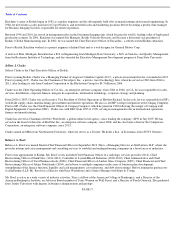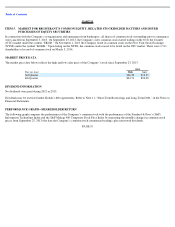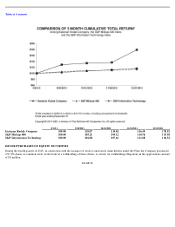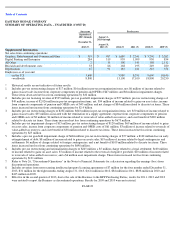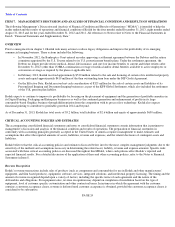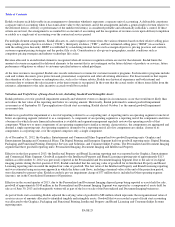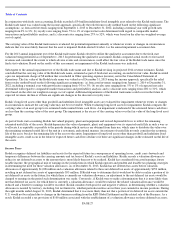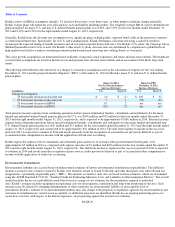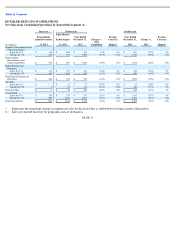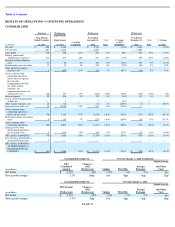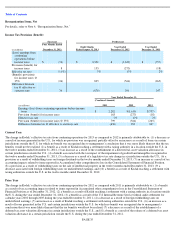Kodak 2013 Annual Report Download - page 27
Download and view the complete annual report
Please find page 27 of the 2013 Kodak annual report below. You can navigate through the pages in the report by either clicking on the pages listed below, or by using the keyword search tool below to find specific information within the annual report.
Table of Contents
Kodak evaluates each deliverable in an arrangement to determine whether it represents a separate unit of accounting. A deliverable constitutes
a separate unit of accounting when it has stand-alone value to the customer, and if the arrangement includes a general right of return relative to
the delivered item(s), delivery or performance of the undelivered item(s) is considered probable and substantially in Kodak’s control. If these
criteria are not met, the arrangement is accounted for as one unit of accounting and the recognition of revenue occurs upon delivery/completion
or ratably as a single unit of accounting over the contractual service period.
For multiple-
element arrangements, Kodak allocates to, and recognizes revenue from, the various elements based on their relative selling price,
using vendor-specific objective evidence (“VSOE”), third-party evidence (“TPE”), and best estimated selling price (“BESP”) in accordance
with the selling price hierarchy. BESP is established by considering internal factors such as margin objectives, pricing practices and controls,
customer segment pricing strategies and the product life cycle. Consideration is also given to geographies, market conditions such as
competitor pricing strategies and industry technology life cycles.
Revenue allocated to an individual element is recognized when all revenue recognition criteria are met for that element. Kodak limits the
amount of revenue recognized for delivered elements to the amount that is not contingent on the future delivery of products or services, future
performance obligations or subject to customer-specified return or refund privileges.
At the time revenue is recognized, Kodak also records reductions to revenue for customer incentive programs. Such incentive programs include
cash and volume discounts, price protection and, promotional, cooperative and other advertising allowances. For those incentives that require
the estimation of sales volumes or redemption rates, such as for volume rebates, Kodak uses historical experience and both internal and
customer data to estimate the sales incentive at the time revenue is recognized. In the event that the actual results of these items differ from the
estimates, adjustments to the sales incentive accruals would be recorded.
Valuation and Useful Lives of Long-Lived Assets, Including Goodwill and Intangible Assets
Kodak performs a test for goodwill impairment annually and whenever events or changes in circumstances occur that would more likely than
not reduce the fair value of the reporting unit below its carrying amount. Historically, Kodak performed its annual goodwill impairment
assessment as of September 30. Upon application of fresh start accounting, Kodak elected October 1 as the annual goodwill impairment
assessment date.
Kodak tests goodwill for impairment at a level of reporting referred to as a reporting unit. A reporting unit is an operating segment or one level
below an operating segment (referred to as a component). A component of an operating segment is a reporting unit if the component constitutes
a business for which discrete financial information is available and segment management regularly reviews the operating results of that
component. When two or more components of an operating segment have similar economic characteristics, the components are aggregated and
deemed a single reporting unit. An operating segment is deemed to be a reporting unit if all of its components are similar, if none of its
components is a reporting unit, or if the segment comprises only a single component.
As of December 31, 2012, the Graphics, Entertainment and Commercial Films Segment had two goodwill reporting units: Graphics and
Entertainment Imaging and Commercial Films. The Digital Printing and Enterprise Segment had four goodwill reporting units: Digital Printing,
Packaging and Functional Printing, Enterprise Services and Solutions, and Consumer Inkjet Systems. The Personalized and Document Imaging
segment had three goodwill reporting units: Personalized Imaging, Document Imaging and Intellectual Property.
Effective in the first quarter of 2013, the Intellectual Property and Brand Licensing reporting unit was reported in the Graphics, Entertainment
and Commercial Films Segment. Goodwill assigned to the Intellectual Property and Brand Licensing reporting unit of approximately $113
million as of December 31, 2012 was previously reported in the Personalized and Document Imaging Segment. Due to the sale of its digital
imaging patents during the first quarter of 2013, Kodak concluded that the carrying value of goodwill for its Intellectual Property and Brand
Licensing reporting unit exceeded the implied fair value of goodwill. The fair value of the Intellectual Property and Brand Licensing reporting
unit was estimated using an income approach in which the future cash flows, including a terminal value at the end of the projection period,
were discounted to present value. Kodak recorded a pre-tax impairment charge of $77 million that is included in Other operating expense
(income), net in the Consolidated Statement of Operations.
Effective in the second quarter of 2013, due to the Personalized and Document Imaging disposal group being reported as assets held for sale,
goodwill of approximately $140 million in the Personalized and Document Imaging Segment was reported as a component of assets held for
sale as of June 30, 2013 and subsequently written-off as part of the loss on sale of the Personalized and Document Imaging businesses.
As part of fresh start accounting, Kodak adjusted the carrying value of goodwill to $88 million which represents the reorganizational value of
assets in excess of amounts allocated to identified tangible and intangible assets. Goodwill that was recorded as part of fresh start accounting
was allocated to the Graphics, Packaging and Functional Printing, Intellectual Property and Brand Licensing and Consumer Inkjet Systems
reporting units.
PAGE 25




